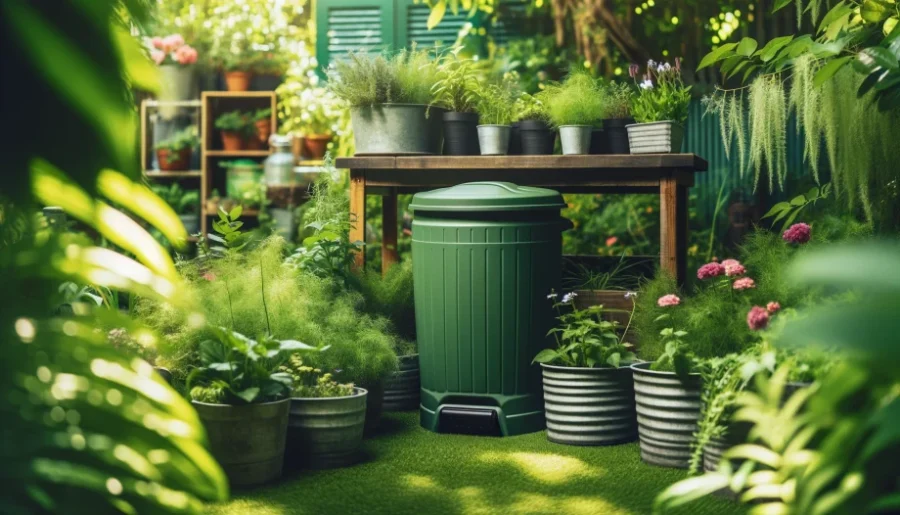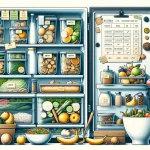
Discover compost bins for small spaces to transform your waste into garden gold! Our guide showcases compact solutions for eco-friendly composting, even in the tiniest of spaces.
Compost Bins for Small Spaces
Key Takeaways:
- Compost Bins for Small Spaces include countertop compost bins for kitchen scraps, worm composting bins for efficient decomposition, garden compost bins, and tumbling compost bins.
- These compact solutions are perfect for apartments, balconies, or small gardens, making composting accessible and convenient for everyone.
Are you looking for compost bins for small spaces? You’re in luck! We’ve got the perfect solutions for eco-conscious urban dwellers.
From countertop wonders to balcony-friendly bins, our guide will help you turn kitchen scraps into nutrient-rich compost, no matter the size of your space.
Compost Bins for Small Spaces
Composting is a great way to reduce waste and enrich your garden soil.
However, not everyone has the luxury of a large backyard. In this post, we’ll explore compost bin options that are perfect for small spaces, such as apartments, balconies, and tiny gardens.
1. Countertop Compost Bins
Countertop compost bins are a convenient solution for small-space composting. They’re designed to fit neatly on your kitchen counter, making it easy to compost food scraps without the need for a large outdoor space.
Here’s a closer look at their features:
Compact Design
- Space-Saving: These bins are small enough to sit on your kitchen counter, taking up minimal space.
- Aesthetic Appeal: Many models come in stylish designs that can complement your kitchen decor.
Odor Control
- Charcoal Filters: Most countertop bins are equipped with charcoal filters to absorb odors and keep your kitchen smelling fresh.
- Tight-Sealing Lids: The lids are designed to seal tightly, preventing any unpleasant smells from escaping.
Ease of Use
- Simple to Use: Just add your food scraps to the bin as you cook or clean up.
- Easy to Empty: When the bin is full, simply empty it into a larger compost system or take it to a local composting service.
Countertop compost bins are a great way to start composting, especially if you’re new to the process or have limited outdoor space.
They offer a simple, odor-controlled way to reduce food waste and contribute to a more sustainable lifestyle.
2. Worm Composting Bins (Vermicomposting)
Worm composting bins, also known as vermicomposting, are an effective and eco-friendly way to compost organic waste.
By using worms to break down food scraps, you can create nutrient-rich compost for your garden while reducing your household waste.
Here’s what you need to know about vermicomposting:
Efficient Decomposition
- Quick Breakdown: Worms can quickly decompose organic matter, turning your kitchen scraps into valuable compost.
- Nutrient-Rich: The compost produced, known as worm castings, is rich in nutrients and beneficial for plant growth.
Indoor Friendly
- No Pests or Odors: When managed properly, worm bins don’t attract pests or produce bad odors, making them suitable for indoor use.
- Compact Size: Worm bins are available in various sizes, making them ideal for small spaces like apartments or balconies.
Educational
- Learning Opportunity: Vermicomposting is an excellent way to learn about the composting process and the importance of natural cycles.
- Hands-On Experience: It provides a hands-on experience in sustainable living and waste reduction.
Worm composting bins are a great addition to any eco-conscious household.
They offer an efficient and odor-free way to compost, while also serving as an educational tool for understanding the natural decomposition process.
3. Bokashi Composting
Bokashi composting is a unique and efficient method for managing organic waste.
This anaerobic process uses a special bran to ferment food waste, including items that are typically not recommended for traditional composting, such as meat and dairy.
Here’s a closer look at the benefits of Bokashi composting:
Anaerobic Process
- Fermentation: Bokashi composting relies on the fermentation of food waste in a sealed container, which prevents the release of unpleasant odors.
- Versatility: This method can handle a wider range of food scraps, including meat, fish, and dairy products, which are not suitable for traditional composting.
Quick Decomposition
- Fast Breakdown: The fermentation process in Bokashi composting can break down organic matter in just a few weeks, much faster than traditional composting methods.
- Convenience: This quick turnaround time makes Bokashi composting an appealing option for those looking to reduce their waste efficiently.
Liquid Fertilizer
- Nutrient-Rich: The Bokashi process produces a liquid byproduct that is rich in nutrients and can be used as a fertilizer for plants.
- Easy to Use: The liquid can be diluted with water and applied directly to the soil, providing a boost of nutrients to your garden.
Bokashi composting is an innovative way to recycle food waste into valuable resources for your garden.
Its quick decomposition and ability to handle a variety of waste materials make it a versatile and practical choice for small spaces and urban settings.
4. Vertical Compost Bins
Vertical garden compost bins are an innovative solution for composting in small spaces.
Their tall, slender design allows them to fit into tight corners or on balconies, making them perfect for urban gardeners.
Let’s explore the advantages of vertical composting systems:
Space-Saving
- Compact Footprint: The vertical design occupies minimal floor space, making it ideal for small gardens or patios.
- Scalable: Some models can be expanded vertically with additional modules, allowing you to increase your composting capacity without taking up more horizontal space.
Aeration
- Optimal Airflow: Vertical compost bins are designed to promote airflow through the compost, which is crucial for the decomposition process.
- Ventilation Features: Many models come with built-in vents or perforations to enhance aeration and speed up the composting process.
Vertical compost bins offer a practical and efficient way to compost in limited spaces.
Their design not only saves valuable floor space but also ensures proper aeration, resulting in faster and more effective composting.
5. Tumbler Compost Bins
Tumbler compost bins are a popular choice for those seeking a convenient and efficient composting solution.
Their rotating design allows for easy mixing and aeration, leading to quicker decomposition of organic material.

I bought a Miracle-Gro Compost Tumbler and have been very happy with it although it was a chore to assemble it works great.
Let’s explore the benefits of using a tumbler compost bin:
Easy to Turn
- Rotating Design: Tumblers are equipped with a handle or mechanism that allows you to easily turn the bin, mixing the composting materials.
- Effortless Aeration: The turning action introduces air into the compost, which is essential for the decomposition process.
Pest-Proof
- Enclosed System: The sealed design of tumbler bins prevents pests like rodents and insects from accessing the compost.
- Odor Control: By containing the compost, tumblers also help to minimize any unpleasant smells.
Faster Decomposition
- Accelerated Process: The constant mixing and aeration provided by tumbling can significantly speed up the composting process.
- Uniform Compost: The tumbling action ensures that the materials break down evenly, resulting in a more consistent compost.
Tumbler compost bins are an excellent option for those looking for a hassle-free composting experience.
Their design makes them easy to use, effective at keeping pests out, and capable of producing compost in a shorter time frame compared to traditional composting methods.
6. DIY Compost Bins
Creating a compost bin using plastic totes is an affordable and easy way to start composting, especially in small spaces.
This method is perfect for beginners and can be customized to fit your needs.
Let’s explore how to set up your own DIY compost bin using plastic totes.
Supplies Needed
- Large Tote: Choose a sturdy plastic tote that can hold your compost.
- Drill: You’ll need a drill to create ventilation holes in the tote.
- Shredded Cardboard: This will serve as the base of your compost bin.
- Dirt: Add some soil from your garden to introduce microorganisms.
- Organic Material: Kitchen scraps like vegetable peels, coffee grounds, and eggshells are perfect for composting.
Steps to Create Your Compost Bin
- Drill Holes: Start by drilling holes all over the tote for air circulation. Make sure to drill holes on the sides, bottom, and lid.
- Add Cardboard: Place shredded cardboard at the bottom of the tote.
- Add Dirt: Sprinkle some garden soil over the cardboard.
- Add Scraps: Collect kitchen scraps and add them to the tote.
- Moisten: Lightly spray the contents with water to keep them damp but not soggy.
- Shake and Mix: Give the tote a good shake to mix everything together.
- Maintenance: Continuously add more scraps and mix them every few days.
Tips for Success
- Balance: Maintain a balance between “greens” (kitchen scraps) and “browns” (cardboard, leaves) for effective composting.
- Location: Keep your bin in a cool, dark area if indoors, or in a shaded spot if outdoors.
- Moisture: Ensure the compost stays damp but not waterlogged to prevent odors and encourage decomposition.
DIY compost bins made from plastic totes are a simple and cost-effective way to reduce waste and create nutrient-rich soil for your garden.
With a little effort and regular maintenance, you can turn your kitchen scraps into black gold for your plants
7. Using Fabric Pots for Composting
Smart Pots Compost Sak Fabric Composter with Plastic Fitted Cover
Fabric pots, also known as Smart Pots or fabric grow bags, offer an innovative solution for composting in small spaces.
They are made from durable, breathable fabric that allows air and water to circulate, promoting a healthy composting process. Here’s how you can use fabric pots for composting:
- Choose the Right Size: Select a fabric pot that fits your composting needs. The Smart Pot Urban Compost Sak is a popular choice for small-space gardeners.
- Set Up Your Compost Bin: Place the fabric pot in a well-drained, sunny, or shaded spot. Unfold the compost bin and add a layer of soil to the bottom.
- Add Compost Materials: Begin adding your compost materials to the bin, mixing green (nitrogen-rich) and brown (carbon-rich) materials. Ensure they are evenly distributed.
- Maintain Moisture: Water the compost bin so that the compost is moist but not soggy. The fabric pot will help excess water drain away while keeping the compost damp.
- Cover the Bin: Use a fitted plastic cover or a lid to protect the compost from rain and retain heat, which is essential for the composting process.
- Regularly Check and Turn: Check the compost bin regularly and turn the contents to ensure proper aeration and decomposition.
- Harvest Your Compost: In a few weeks, you’ll have nutrient-rich compost that you can use to fertilize your plants. Simply empty the compost into your garden or flower beds.
Fabric pots like the Smart Pot Urban Compost Sak are a convenient and effective way to compost, especially for those with limited outdoor space.
They are easy to set up, and maintain, and can be added to your garden, deck, or balcony.
How to Compost in a Small Space With Fabric Pots
Here is a video that shows you how to use fabric pots for composters.
Composting in Small Spaces FAQs
Composting in small spaces can be a bit tricky, but with the right approach, it’s entirely possible.
Here are some commonly asked questions and answers to help you get started with composting in limited areas:
Q: How do you compost in a small space?
A: You can compost in a small space using a compact compost bin like a tumbler or a bokashi bin. These bins are designed to fit in tight spaces and can be kept indoors or on a balcony.
Q: What is the best compost for small spaces?
A: The best compost for small spaces is usually made in a tumbler, worm bin, or bokashi bin, as these systems are compact and efficient. They can handle kitchen scraps and produce compost relatively quickly.
Q: What can I use instead of a compost bin?
A: Instead of a traditional compost bin, you can use a plastic tote, worm bin, or bokashi bucket, or even a 5-gallon bucket with a lid. These alternatives are great for small spaces and can be easily managed indoors or on a balcony.
Q: What is the minimum size for a compost bin?
A: The minimum size for a compost bin depends on the amount of organic waste you produce. For small households, a bin with a capacity of around 5 gallons should be sufficient.
Q: Should your compost bin have a lid?
A: Yes, your compost bin should have a lid to retain moisture, keep pests out, and prevent odors from escaping. A lid also helps maintain the right temperature for decomposition.
Q: Do compost bins need bottoms?
A: Compost bins do not necessarily need bottoms, especially if placed directly on the ground outdoors, as this allows worms and microorganisms to enter the bin and aid in decomposition.
However, indoor bins with bottoms are needed to contain the compost and prevent leachate from seeping out.
Q: Should compost bin be in sun or shade?
A: A compost bin can be placed in either sun or shade, but a sunny spot can help speed up the composting process by increasing the temperature inside the bin. However, make sure the compost doesn’t dry out if it’s in full sun.
Q: Why put cardboard under compost?
A: Putting cardboard under compost can help absorb excess moisture, prevent weeds from growing up in the bin, and provide a carbon-rich material that balances the nitrogen-rich kitchen scraps in the compost.
Q: Should a compost bin be wet or dry?
A: A compost bin should be moist, but not too wet. The consistency should be like a wrung-out sponge.
If it’s too dry, decomposition will slow down; if it’s too wet, it can become smelly and anaerobic.
Q: Do grass clippings make good compost?
A: Yes, grass clippings can make good compost as they are rich in nitrogen.
However, it’s important to mix them with carbon-rich materials like leaves or straw to balance the compost and prevent it from becoming too wet and compacted.
Q: Do eggshells compost?
A: Yes, eggshells do compost, but they break down slowly. It’s a good idea to crush them before adding them to your compost bin to speed up the decomposition process.
Q: Can you compost toilet paper rolls?
A: Yes, you can compost toilet paper rolls. They are made from paper and will break down in a compost bin. Shredding them first can help speed up the decomposition process.
Compost Bins for Small Spaces Conclusion
Even if you’re short on space, there’s a compost bin that can fit your needs.
Whether you choose a countertop bin, a worm composter, or a tumbler, you’ll be doing your part to reduce waste and create valuable compost for your plants.
Remember, every little bit helps when it comes to living more sustainably!
Here are some final thoughts and tips to keep in mind as you embark on your composting journey:
Commitment to Sustainability
- Long-Term Impact: Your efforts in composting contribute to a healthier planet by reducing landfill waste and creating nutrient-rich soil.
- Eco-Friendly Habits: Composting is just one aspect of a sustainable lifestyle. Consider other ways to reduce your environmental footprint, such as recycling, conserving water, and reducing energy consumption.
Continued Learning
- Stay Informed: Keep up with the latest composting techniques, tips, and trends to improve your composting process.
- Community Involvement: Join local gardening or composting groups to share experiences, learn from others, and stay motivated.
Future Goals
- Expanding Your Composting: As you become more comfortable with composting, consider increasing the size of your compost bin or trying new composting methods.
- Garden Integration: Use your compost to enrich your garden soil, leading to healthier plants and a more productive garden.
In conclusion, composting in small spaces is not only possible but also rewarding.
By committing to compost, you’re taking a significant step towards sustainability and contributing to a healthier environment.
Keep learning, stay committed, and enjoy the fruits of your labor in the form of rich, homemade compost.
Resources on Home Composting
Here are some educational resources from .edu websites to help you get started with home composting:
- Penn State Extension – Home Composting: A Guide for Home Gardeners This guide provides detailed information on what to include in your compost pile, the importance of the carbon-to-nitrogen ratio, and how to prepare materials for composting. It also offers tips on maintaining your compost pile. Read more
- University of Maryland Extension – How to Make Compost at Home Learn about compost temperature control, sheet composting, and trench composting in this comprehensive guide. Read more
- University of Minnesota Extension – Composting in Home Gardens Explore different types of compost bins, including cement block, barrel, portable wood and wire, and three-chambered composting bins. This resource also covers where to locate your compost pile and what materials are compostable. Read more
- Indiana University Environmental Resilience Institute – Home Composting This page provides statistics on compost and waste, and outlines what can and cannot be composted. It also offers tips on setting up and maintaining a home composting operation. Read more
- NC State Extension – Home & Backyard Composting Find information on the benefits of composting, what can be composted, and how to set up and maintain a composting system at home. Read more
- Texas A&M AgriLife Extension – Home Composting Good for Garden, Environment This article provides insights into building a compost pile, temperature control in composting, and how to use the finished product in your garden. Read more
- University of Florida IFAS Extension – Compost Tips for the Home Gardener Learn how to use compost in your garden, including as a soil amendment, mulch, or component of a potting mix. This resource also covers troubleshooting common composting problems. Read more
- Texas A&M AgriLife Extension Service – Easy Gardening: Composting This publication explains what materials to use for composting, how to build a compost bin, and what elements and conditions are essential for decomposition to occur. Read more
- Cornell Waste Management Institute – Small Scale or Backyard Composting This resource provides information on composting at home, including how to choose a compost unit and tips for small-scale composting. Read more














